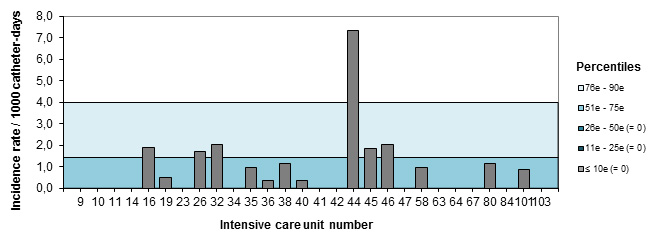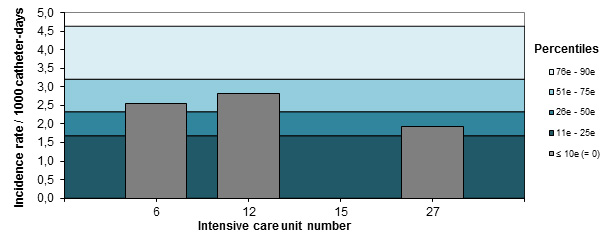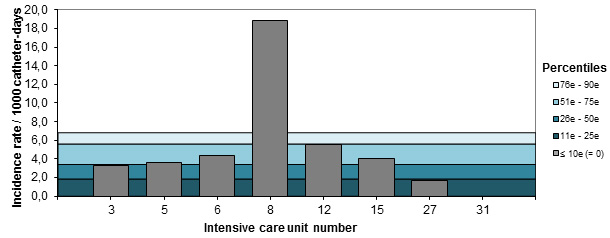Central Line–Associated Bloodstream Infections in Intensive Care Units: surveillance 2013-2014

From April 1st, 2013, to March 31st, 2014, 70 intensive care units (ICUs) took part in surveillance of central line–associated bloodstream infections (CLABSIs), for a combined total of 132,376 catheter-days (Table 1). Participating ICUs reported 165 CLABSIs in 149 patients. Incidence rates were 0.65 per 1,000 catheter-days in coronary ICUs, 0.71 in teaching adult ICUs, 0.77 in non-teaching adult ICUs, 2.48 in pediatric ICUs and 4.01 in neonatal ICUs. The incidence rates in 2013-2014 were lower compared to 2009-2013 in teaching and non-teaching adult ICUs as well as in neonatal ICUs while pediatric and coronary ICUs pooled mean rates remained statistically stable. Compared to 2012-2013, two adult non-teaching ICUs with less than 10 beds and a neonatal ICU joined the program and none discontinued their participation. Data were extracted on May 15, 2014.
Update : March 8, 2017
Table 1 – Participation of ICUs in the Surveillance of CLABSIs, Québec, 2009-2010 to 2013-2014
2009-2010 | 2010-2011 | 2011-2012 | 2012-2013 | 2013-2014 | |
|---|---|---|---|---|---|
| Participating ICUs (N) | 61 | 64 | 66 | 67 | 70 |
| Patient-days (N) | 255,604 | 275,653 | 287,553 | 294,438 | 301,333 |
| Catheter-days (N) | 115,829 | 123,899 | 127,391 | 128,207 | 132,376 |
| CLABSIs (cat. 1a + 1b, N) | 185 | 194 | 203 | 201 | 165 |
| Infected patients (N) | 179 | 185 | 191 | 197 | 149 |
Incidence rates
In 2013-2014, incidence rates were 0.65 per 1,000 catheter-days in coronary ICUs, 0.71 in teaching adult ICUs, 0.77 in non-teaching adult ICUs, 2.48 in pediatric ICUs and 4.01 in neonatal ICUs. The lowest pooled mean rate was found in adult teaching ICUs (including coronary ICUs), despite the fact that these units had the highest use of central lines (Table 2). The CLABSI incidence rate was highest in neonatal and pediatric ICUs, and these rates were significantly higher than that of adult ICUs (p < 0.05).
Table 2 – CLABSI Incidence Rate and Catheter Utilization Ratio, by Type of Healthcare Facility and Type of ICU, Québec, 2013-2014 (Incidence Rate per 1,000 Catheter-days [95% CI])
| Type of ICU | ICUs (N) | Incidence Rate | Utilization Ratio |
|---|---|---|---|
| Coronary | 3 | 0.65 [0.06 ; 1.86] | 0.24 |
| Adult, teaching | 27 | 0.71 [0.53 ; 0.91] | 0.61 |
| Adult, non-teaching | 28 | 0.77 [0.48 ; 1.12] | 0.38 |
| Pediatric | 4 | 2.48 [1.44 ; 3.80] | 0.60 |
| Neonatal | 8 | 4.01 [3.13 ; 5.01] | 0.23 |
95% CI: 95% confidence interval.
In 2013-2014, all neonatal ICUs provided the number of catheter-days by birth weight category which allows to note that incidence rates did tend to be higher among small birth weight babies (Table 3).
Table 3 – CLABSI Incidence Rate in Neonatal ICUs, by Birth Weight Category, Québec, 2013-2014 (Incidence Rate per 1,000 Catheter-days [95% CI])
| Birth Weight Category (grams) | Number of Cases | Incidence Rate |
|---|---|---|
| ≤ 750 | 19 | 7.06 [4.24 ; 10.59] |
| 751-1,000 | 14 | 4.15 [2.26 ; 6.61] |
| 1,001-1,500 | 14 | 3.53 [1.92 ; 5.63] |
| 1,501-2,500 | 9 | 2.95 [1.34 ; 5.20] |
| > 2,500 | 14 | 3.19 [1.74 ; 5.09] |
| Total | 70 | 4.01 [3.13 ; 5.01] |
Incidence rate trends
In 2013-2014, compared to the previous four years (Figure 1), CLABSI incidence rates declined significantly in adult teaching ICUs (p = 0.02), in adult non teaching ICUs (p = 0.03) and neonatal ICUs (p = 0.03), but remained stable in pediatric ICUs (p > 0.05) and coronary ICUs (p > 0.05).
Figure 1 – CLABSI Incidence Rate, by Type of Healthcare Facility and Type of ICU, in ICUs that previously participated in SPIN (N = 67), Québec, 2009-2013 and 2013-2014 (Incidence Rate per 1,000 Catheter-days [I.C. 95%])

In addition to the marked decrease of CLABSI rates, a significant increase (p < 0,05) of catheter utilization ratios was observed in adult non teaching and neonatal ICUs. The catheter utilization ratio decreased significantly in adult teaching ICUs and remained stable in pediatric and coronary ICUs (Figure 2).
Figure 2 – Catheter Utilization Ratio, by Type of Healthcare Facility and Type of ICU, in ICUs that previously participated in SPIN (N = 67), Québec, 2009-2013 and 2013-2014

Description of cases
Patients who developed a CLABSI were aged between 0 and 83 years, with a median age of 61 years old in the adult ICUs and of a little less than one month old in pediatric and neonatal ICUs. In adult ICUs, the central lines most frequently associated with bloodstream infections were the 'other' central venous catheters (CVCs) that included central lines previously named 'regular' CVCs, followed by peripherally inserted central catheters (PICCs) (Figure 3). In neonatal ICUs, PICCs were the most frequently associated with CLABSI, followed by umbilical catheters.
Figure 3 – Type of Central Line Used in CLABSI Cases, by Type of Healthcare Facility and Type of ICU, Québec, 2013-2014 (N)

NB: More than one central line may be reported in any given case of CLABSI, which explains why the total number of central lines is higher than the total number of CLABSIs presented earlier in this paper.
In 2013-2014, 16% of CLABSI cases died in the 30 days after bacteremia onset (Table 4). Case fatality was 100% in coronary ICUs (Figure 4) but the number of cases was very small. The overall mortality rate of 16% is not a significant decrease compared to the case fatality of 23% observed in 2012-2013 (p > 0.05).
Figure 4 – 30-Day Case Fatality, by Type of Healthcare Facility and Type of ICU, Québec, 2013-2014 (%)

Table 4 – 30-Day Case Fatality, by Type of Healthcare Facility and Type of ICU, Québec, 2013-2014 (N, %)
| Type of ICU | CLABSIs N | Death in 10 Days | Death in 30 Days | ||
|---|---|---|---|---|---|
| N | % | N | % | ||
| Coronary | 2 | 1 | 50 | 2 | 100 |
| Adult, teaching | 54 | 9 | 17 | 13 | 24 |
| Adult, non-teaching | 22 | 3 | 14 | 4 | 18 |
| Pediatric | 17 | 1 | 6 | 1 | 6 |
| Neonatal | 70 | 5 | 7 | 7 | 10 |
| Total | 165 | 19 | 12 | 27 | 16 |
Microbiology
Figure 5 shows that the microorganisms most frequently isolated in reported CLABSI cases were coagulase-negative staphylococci (CoNS, 41%), followed by Enterococcus sp. (16%) then Candida sp. (13%). However, Candida sp. was the microorganism present in more than a third of cases resulting in death (37%).
Figure 5 – Categories of Isolated Microorganisms in All Cases (N = 187) and Cases of Mortality Within 30 Days (N = 30), Québec, 2013-2014 (%)
Isolated Microorganisms—All Cases Isolated Microorganisms—Mortality Within 30 Days

In 2013-2014, 11% of S. aureus strains were resistant to oxacillin; 9% of Gram-negative bacteria showed resistance to piperacillin/tazobactam. Two Enterococcus faecium strains were vancomycin-resistant (Table 5 and Figure 6).
Table 5 – Percentage of Strains Tested and Percentage of Resistance to Antibiotics for Certain Isolated Microorganisms, Québec, 2012-2013 (N, %)
| Microorganism | Antibiotic | Isolated | Tested | Resistant | ||
|---|---|---|---|---|---|---|
N | n | % | n | % | ||
| Staphylococcus aureus | Oxacillin | 18 | 18 | 100.0 | 2 | 11.1 |
| Enterococcus faecium | Vancomycin | 6 | 6 | 100.0 | 2 | 33.3 |
| Enterococcus faecalis | Vancomycin | 22 | 22 | 100.0 | 0 | 0.0 |
| Klebsiella (pneumoniae-oxytoca) | CSE 4 | 0 | 0 | - | 0 | - |
| Imipenem or meropenem | 0 | 0 | - | 0 | - | |
| Multiresistant 1 | 0 | 0 | - | 0 | - | |
| Escherichia coli | CSE 4 | 8 | 7 | 87.5 | 0 | 0.0 |
| Fluoroquinolones 3 | 8 | 5 | 62.5 | 1 | 20.0 | |
| Imipenem or meropenem | 8 | 3 | 37.5 | 0 | 0.0 | |
| Multiresistant 1 | 8 | 7 | 87.5 | 1 | 14.3 | |
| Enterobacter sp. | CSE 4 | 6 | 6 | 100.0 | 1 | 16.7 |
| Imipenem or meropenem | 6 | 5 | 83.3 | 0 | 0.0 | |
| Multiresistant 1 | 6 | 6 | 100.0 | 0 | 0.0 | |
| Pseudomonas sp. | Amikacin, gentamicin or tobramycin | 1 | 1 | 100.0 | 0 | 0.0 |
| CSE 2 | 1 | 1 | 100.0 | 0 | 0.0 | |
| Fluoroquinolones 2 | 1 | 1 | 100.0 | 0 | 0.0 | |
| Imipenem or meropenem | 1 | 1 | 100.0 | 0 | 0.0 | |
| Piperacillin/tazobactam | 1 | 1 | 100.0 | 0 | 0.0 | |
| Multiresistant 2 | 1 | 1 | 100.0 | 0 | 0.0 | |
| Acinetobacter sp. | Imipenem or meropenem | 1 | 1 | 100.0 | 0 | 0.0 |
| Multiresistant 3 | 1 | 1 | 100.0 | 0 | 0.0 | |
CSE 4: cefepime, cefotaxime, ceftazidime or ceftriaxone; CSE 2: cefepime or ceftazidime.
Fluoroquinolones 2: ciprofloxacin or levofloxacin;
Fluoroquinolones 3: ciprofloxacin, levofloxacin or moxifloxacin;
Multiresistant 1: intermediate or resistant to an agent in three of the following five categories: cephalosporins 4, fluoroquinolones 3, aminoglycosides, carbapenems, piperacillin or piperacillin/tazobactam.
Multiresistant 2: intermediate or resistant to an agent in three of the following five categories: cephalosporins 2, fluoroquinolones 2, aminoglycosides, carbapenems, piperacillin or piperacillin/tazobactam.
Multiresistant 3: intermediate or resistant to an agent in three of the following six categories: cephalosporins 2, fluoroquinolones 2, aminoglycosides, carbapenems, piperacillin or piperacillin/tazobactam, ampicillin/sulbactam
Figure 6 – Antibiotic Resistance in Gram-Positive Bacteria, Gram-Negative Bacteria and Pseudomonas sp., Québec, 2009-2010 to 2013-2014 (%)

Results per ICU
In 2013-2014, all participating coronary and pediatric ICUs remained below the 90th percentile compared to the 2009-2010 to 2012-2013 rates, which suggests an improvement of CLABSI rates (Figures 7 and 10). Only two adult teaching and one adult non-teaching ICUs ranked above the 90th percentile in their respective units type (less than 10% of ICUs, figures 8 and 9). The proportion of neonatal ICUs above the 90th percentile is roughly 10% (13%), which is expected (Figure 11). Tables 6 and 7 present the numerical values that correspond to the rates displayed in Figures 7 through 11. Tables 8 and 9 show the catheter utilization rates for each ICU.
Figure 7 – CLABSI Incidence Rate per ICU (2013-2014) and Percentile Ranking (2009-2010 to 2012-2013), Coronary ICUs, Québec, 2013-2014 (Incidence Rate per 1,000 Catheter-days)

Figure 8 – CLABSI Incidence Rate per ICU (2013-2014) and Percentile Ranking (2009-2010 to 2012-2013), Teaching Adult ICUs, Québec, 2013-2014 (Incidence Rate per 1,000 Central-Lin

Figure 9 – CLABSI Incidence Rate per ICU (2013–2014) and Percentile Ranking (2009-2010 to 2012-2013), Non-Teaching Adult ICUs, Québec, 2013-2014 (Incidence Rate per 1,000 Catheter-days)

Figure 10 – CLABSI Incidence Rate (2013-2014) and Percentile Ranking (2009-2010 to 2012-2013) per ICU, Pediatric ICUs, Québec, 2013-2014 (Incidence Rate per 1,000 Catheter-days)

Figure 11 - CLABSI Incidence Rate (2013-2014) and Percentile Ranking (2009-2010 to 2012-2013), per ICU, Neonatal ICUs, Québec, 2013-2014 (Incidence Rate per 1,000 Catheter-days)

NB for Figures 7 to 11: In healthcare facilities with more than one type of ICU: S = surgical, M = medical, X = mixed and B = burn trauma.
Table 6 – CLABSI Incidence Rate per ICU, Distribution of CLABSI rates for 2009-2013 and the Ministry’s Strategic Planning Threshold, by ICU Types, for Teaching Healthcare Facilities, Québec, 2013-2014 (Incidence Rate per 1,000 Catheter-days)
| Facility | Adult, teaching* | Coronary | Pediatric | Neonatal | |
|---|---|---|---|---|---|
1 | HÔPITAL CHARLES LEMOYNE | 0.41 | |||
2 | HÔPITAL DE L'ENFANT-JÉSUS | 4.27-B | |||
2 | HÔPITAL DE L'ENFANT-JÉSUS | 0.92-X | |||
3 | HÔPITAL ROYAL VICTORIA | 1.57 | 0.88 | 3.28 | |
4 | HÔPITAL NOTRE-DAME DU CHUM | 1.11 | |||
5 | HÔPITAL GÉNÉRAL JUIF | 0.22 | 3.62 | ||
6 | L'HÔPITAL DE MONTRÉAL POUR ENFANTS | 2.54 | 4.35 | ||
7 | PAVILLON L'HÔTEL-DIEU DE QUÉBEC | 0.00 | |||
8 | PAV. MAISONNEUVE/PAV. MARCEL-LAMOUREUX | 0.86 | 1.00 | 18.87 | |
12 | CENTRE HOSPITALIER UNIVERSITAIRE SAINTE-JUSTINE | 2.83 | 5.52 | ||
13 | INSTITUT DE CARDIOLOGIE DE MONTRÉAL | 0.00 | |||
15 | HÔPITAL FLEURIMONT | 0.41-C | 0.00 | 4.06 | |
15 | HÔPITAL FLEURIMONT | 0.62-M | |||
18 | HÔTEL-DIEU DE LÉVIS | 1.56 | |||
20 | HÔPITAL DE CHICOUTIMI | 0.00 | |||
21 | HÔPITAL SAINT-LUC DU CHUM | 0.35 | |||
22 | HÔTEL-DIEU DU CHUM | 3.97-B | 0.00 | ||
22 | HÔTEL-DIEU DU CHUM | 1.15-X | |||
25 | HÔPITAL DU SACRÉ-COEUR DE MONTRÉAL | 0.72 | |||
27 | PAVILLON CH DE L'UNIVERSITÉ LAVAL | 0.00 | 1.94 | 1.65 | |
28 | PAVILLON SAINT-FRANCOIS D'ASSISE | 0.00 | |||
29 | HÔPITAL GÉNÉRAL DE MONTRÉAL | 0.75 | |||
30 | HOTEL-DIEU DE SHERBROOKE | 1.18 | |||
31 | PAVILLON SAINT-JOSEPH | 0.78 | 0.00 | ||
33 | INSTITUT UNIVERSITAIRE DE CARDIOLOGIE ET DE PNEUMOLOGIE DE QUÉBEC | 0.00-C | |||
33 | INSTITUT UNIVERSITAIRE DE CARDIOLOGIE ET DE PNEUMOLOGIE DE QUÉBEC | 0.00-X | |||
48 | CENTRE HOSPITALIER DE ST. MARY | 0.00 | |||
116 | INSTITUT THORACIQUE DE MONTRÉAL | 0.82 | |||
118 | HÔPITAL NEUROLOGIQUE DE MONTRÉAL | 1.63 | |||
2009-2013 | 10th | 0.00 | 0.00 | 0.00 | 0.00 |
| 25th | 0.27 | 0.00 | 1.69 | 1.85 | |
| 50th | 1.03 | 0.98 | 2.33 | 3.42 | |
| 75th | 1.61 | 1.34 | 3.21 | 5.61 | |
| 90th | 2.17 | 3.17 | 4.64 | 6.83 | |
Strategic planning threshold** | 3.15 | - | 3.32 | 6.62 | |
* In healthcare facilities with more than one type of adult ICU: S = surgical, M = medical, X = mixed and B = burn trauma.
** This threshold represents the 90th percentile for 2007-2009 rates.
Table 7 – CLABSI Incidence Rate per ICU, Distribution of CLABSI rates for 2009-2013 and the Ministry’s Strategic Planning Threshold, by ICU Types, for Non-teaching Healthcare Facilities, Québec, 2013-2014 (Incidence Rate per 1,000 Catheter-days)
| Facility | Adult, Non-teaching | |
|---|---|---|
9 | HÔPITAL DU HAUT-RICHELIEU | 0.00 |
10 | HÔPITAL PIERRE-BOUCHER | 0.00 |
11 | HÔPITAL PIERRE-LE GARDEUR | 0.00 |
14 | CENTRE HOSPITALIER RÉGIONAL DE LANAUDIÈRE | 0.00 |
16 | HÔPITAL RÉGIONAL DE RIMOUSKI | 1.92 |
19 | HÔPITAL CITÉ DE LA SANTÉ | 0.50 |
23 | HÔTEL-DIEU D'ARTHABASKA | 0.00 |
26 | HÔPITAL DE VERDUN | 1.69 |
32 | CENTRE HOSPITALIER RÉGIONAL DU GRAND-PORTAGE | 2.06 |
34 | HÔPITAL SANTA CABRINI | 0.00 |
35 | HÔPITAL HONORÉ-MERCIER | 0.98 |
36 | HÔPITAL GÉNÉRAL DU LAKESHORE | 0.37 |
38 | HÔPITAL JEAN-TALON | 1.16 |
40 | HÔPITAL DE HULL | 0.35 |
41 | HÔPITAL DU CENTRE-DE-LA-MAURICIE | 0.00 |
42 | HÔPITAL ANNA-LABERGE | 0.00 |
44 | HÔPITAL SAINTE-CROIX | 7.35 |
45 | HÔPITAL DE SAINT-EUSTACHE | 1.85 |
46 | HÔPITAL DE GRANBY | 2.02 |
47 | HÔPITAL DE ROUYN-NORANDA | 0.00 |
58 | HÔPITAL DU SUROÎT | 0.95 |
63 | HÔPITAL DE SAINT-GEORGES | 0.00 |
64 | HÔPITAL LE ROYER | 0.00 |
67 | HÔPITAL ET CENTRE DE RÉADAPTATION DE JONQUIÈRE | 0.00 |
80 | HÔPITAL FLEURY | 1.17 |
84 | HÔPITAL DE NOTRE-DAME-DU-LAC | 0.00 |
101 | HÔPITAL RÉGIONAL DE SAINT-JÉRÔME | 0.86 |
103 | HÔPITAL LAURENTIEN | 0.00 |
2009-2013 percentile ranking | 10th | 0.00 |
| 25th | 0.00 | |
| 50th | 0.00 | |
| 75th | 1.44 | |
| 90th | 4.00 | |
Strategic planning threshold* | 3.30 | |
*This threshold represents the 90th percentile for 2007-2009 rates.
Table 8 – Catheter Utilization Ratio per ICU, Distribution of Ratios for 2009-2013, by ICU Types, for Teaching Healthcare Facilities, Québec, 2013-2014
| Facility | Adult, teaching* | Coronary | Pediatric | Neonatal | |
|---|---|---|---|---|---|
1 | HÔPITAL CHARLES LEMOYNE | 0.47 | 0.61 | ||
2 | HÔPITAL DE L'ENFANT-JÉSUS | 0.16-B | |||
2 | HÔPITAL DE L'ENFANT-JÉSUS | 0.45-X | |||
3 | HÔPITAL ROYAL VICTORIA | 0.90 | 0.17 | 0.29 | |
4 | HÔPITAL NOTRE-DAME DU CHUM | 0.89 | |||
5 | HÔPITAL GÉNÉRAL JUIF | 0.76 | 0.15 | ||
6 | L'HÔPITAL DE MONTRÉAL POUR ENFANTS | 0.61 | 0.54 | ||
7 | PAVILLON L'HÔTEL-DIEU DE QUÉBEC | 0.65 | |||
8 | PAV. MAISONNEUVE/PAV. MARCEL-LAMOUREUX | 0.59 | 0.32 | 0.02 | |
12 | CENTRE HOSPITALIER UNIVERSITAIRE SAINTE-JUSTINE | 0.68 | 0.21 | ||
13 | INSTITUT DE CARDIOLOGIE DE MONTRÉAL | 0.94 | |||
15 | HÔPITAL FLEURIMONT | 0.64-C | 0.31 | 0.29 | |
15 | HÔPITAL FLEURIMONT | 0.38-M | |||
18 | HÔTEL-DIEU DE LÉVIS | 0.29 | |||
20 | HÔPITAL DE CHICOUTIMI | 0.69 | |||
21 | HÔPITAL SAINT-LUC DU CHUM | 0.83 | |||
22 | HÔTEL-DIEU DU CHUM | 0.51-B | 0.32 | ||
22 | HÔTEL-DIEU DU CHUM | 0.97-X | |||
25 | HÔPITAL DU SACRÉ-COEUR DE MONTRÉAL | 0.56 | |||
27 | PAVILLON CH DE L'UNIVERSITÉ LAVAL | 0.16 | 0.53 | 0.16 | |
28 | PAVILLON SAINT-FRANCOIS D'ASSISE | 0.33 | |||
29 | HÔPITAL GÉNÉRAL DE MONTRÉAL | 0.72 | |||
30 | HOTEL-DIEU DE SHERBROOKE | 0.22 | |||
31 | PAVILLON SAINT-JOSEPH | 0.54 | 0.01 | ||
33 | INSTITUT UNIVERSITAIRE DE CARDIOLOGIE ET DE PNEUMOLOGIE DE QUÉBEC | 0.97-C | |||
33 | INSTITUT UNIVERSITAIRE DE CARDIOLOGIE ET DE PNEUMOLOGIE DE QUÉBEC | 0.40-X | |||
48 | CENTRE HOSPITALIER DE ST. MARY | 0.52 | |||
116 | INSTITUT THORACIQUE DE MONTRÉAL | 0.59 | |||
118 | HÔPITAL NEUROLOGIQUE DE MONTRÉAL | 0.17 | |||
2009-2013 percentile ranking* | 10th | 0.29 | 0.17 | 0.21 | 0.01 |
| 25th | 0.41 | 0.21 | 0.38 | 0.11 | |
| 50th | 0.59 | 0.25 | 0.50 | 0.19 | |
| 75th | 0.82 | 0.35 | 0.64 | 0.28 | |
| 90th | 0.96 | 0.41 | 0.75 | 0.50 | |
* In healthcare facilities with more than one type of adult ICU: S = surgical, M = medical, X = mixed and B = burn trauma.
Table 9 – Catheter Utilization Ratio per ICU, Breakdown for 2009-2013, by ICU Types, for Non-teaching Healthcare Facilities, Québec, 2013-2014
| Facility | Adult, non-teaching | |
|---|---|---|
9 | HÔPITAL DU HAUT-RICHELIEU | 0.24 |
10 | HÔPITAL PIERRE-BOUCHER | 0.30 |
11 | HÔPITAL PIERRE-LE GARDEUR | 0.57 |
14 | CENTRE HOSPITALIER RÉGIONAL DE LANAUDIÈRE | 0.24 |
16 | HÔPITAL RÉGIONAL DE RIMOUSKI | 0.19 |
19 | HÔPITAL CITÉ DE LA SANTÉ | 0.41 |
23 | HÔTEL-DIEU D'ARTHABASKA | 0.09 |
26 | HÔPITAL DE VERDUN | 0.51 |
32 | CENTRE HOSPITALIER RÉGIONAL DU GRAND-PORTAGE | 0.32 |
34 | HÔPITAL SANTA CABRINI | 0.22 |
35 | HÔPITAL HONORÉ-MERCIER | 0.31 |
36 | HÔPITAL GÉNÉRAL DU LAKESHORE | 0.74 |
38 | HÔPITAL JEAN-TALON | 0.43 |
40 | HÔPITAL DE HULL | 0.69 |
41 | HÔPITAL DU CENTRE-DE-LA-MAURICIE | 0.08 |
42 | HÔPITAL ANNA-LABERGE | 0.39 |
44 | HÔPITAL SAINTE-CROIX | 0.11 |
45 | HÔPITAL DE SAINT-EUSTACHE | 0.35 |
46 | HÔPITAL DE GRANBY | 0.22 |
47 | HÔPITAL DE ROUYN-NORANDA | 0.26 |
58 | HÔPITAL DU SUROÎT | 0.37 |
63 | HÔPITAL DE SAINT-GEORGES | 0.08 |
64 | HÔPITAL LE ROYER | 0.11 |
67 | HÔPITAL ET CENTRE DE RÉADAPTATION DE JONQUIÈRE | 0.16 |
80 | HÔPITAL FLEURY | 0.80 |
84 | HÔPITAL DE NOTRE-DAME-DU-LAC | 0.28 |
101 | HÔPITAL RÉGIONAL DE SAINT-JÉRÔME | 0.79 |
103 | HÔPITAL LAURENTIEN | 0.12 |
2009-2013 percentile ranking | 10th | 0.13 |
| 25th | 0.18 | |
| 50th | 0.31 | |
| 75th | 0.44 | |
| 90th | 0.60 | |
Author
Comité de surveillance provinciale des infections nosocomiales (SPIN) – bactériémies sur cathéters centraux aux soins intensifs
Editorial Committee
Élise Fortin, Direction des risques biologiques et de la santé au travail, Institut national de santé publique du Québec
Muleka Ngenda-Muadi, Direction des risques biologiques et de la santé au travail, Institut national de santé publique du Québec
Caroline Quach, Centre universitaire de santé McGill, Hôpital de Montréal pour enfants
Isabelle Rocher, Direction des risques biologiques et de la santé au travail, Institut national de santé publique du Québec
Mélissa Trudeau, Direction des risques biologiques et de la santé au travail, Institut national de santé publique du Québec

